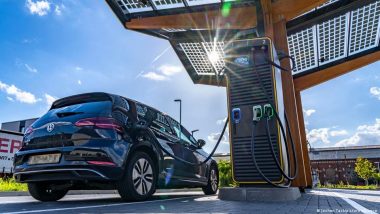More demand for heat pumps, increasing solar energy in the power supply and a boom in battery construction benefiting e-mobility were just a few of the green energy trends this year.Fossil fuels still supply around 80% of the world's energy needs but 2023 saw some significant advancements in renewable power.
Also Read | Business News | Manage Your Credit Health With The Bajaj Finserv Credit Pass.
The intergovernmental International Energy Agency (IAE) said that global renewable energy capacity experienced its largest ever growth, calling the increase "unprecedented."
Overall, 2023 was a watershed moment for the global energy landscape, with renewable sources like solar and wind as well as other innovative technologies shaping a more sustainable future, according to experts.
Solar driving energy transformation
Claudia Kemfert of the Berlin-based German Institute for Economic Research told DW that the increasing affordability of renewable power had led to a turning point for energy systems.
"For the first time, more investments are flowing into solar energy than into oil extraction," added Kemfert.
Solar completely exceeded expectations "once again" as a result, said Gunnar Luderer, an energy systems expert at Germany's Potsdam Institute for Climate Impact Research (PIK).
New solar power installations around the globe were expected to hit a total capacity of 400 gigawatts (GW), according to forecasts. In 2022, the increase was 239 GW.
Some 110 GW of wind power was newly connected to the grid in 2023, according to the World Wind Energy Association.
This year also saw the completion of four new nuclear reactors with a total capacity of 4 GW, while five old reactors with a capacity of 6 GW were decommissioned in Germany, Belgium, and Taiwan.
Solar and wind power make electricity generation cheaper
The favorable cost of electricity from renewables was one of the main reasons behind a strong growth in wind and solar.
Electricity produced by new onshore wind turbines cost 3-euro cents (3-US cents) per kilowatt-hour (kWh) in 2022 on average worldwide, according to a report by the International Renewable Energy Agency (IRENA).
Electricity produced in large solar parks was 4.5-euro cents per kWh. That's significantly cheaper than fossil fuels, which cost up to 22-euro cents per kWh globally.
The price of electricity from new solar installations continued to drop in the past 12 months, primarily because solar modules have become more affordable. In Europe, costs were 40% lower than last year.
Solar modules produced more affordably, especially in China
China's expansion of solar module production was one of the main drivers of falling prices. According to UK-based environment website Carbon Brief, the country is producing 600 GW of solar cells annually — 225 GW more than in 2022. By 2025, it could reach 1000 GW.
India, the US, and the EU also plan to invest more in large solar factories. In India, modules with an annual capacity of 100 GW are set to be manufactured from 2027, and companies in the EU will start manufacturing modules with a 30 GW in 2025.
"It's happening faster than expected," said Niklas Höhne from the New Climate Institute, a think tank based in Cologne, Germany. "In particular, photovoltaics are being expanded extremely quickly. And, in fact, so quickly as to align with the 1.5-degree Celsius goal."
New battery technologies and more electric vehicles
"The year 2023 could go down in history as the turning point for batteries in the global energy transition," said Christian Breyer, a professor of solar economics at LUT University in Finland.
Lithium, cobalt and nickel batteries are all well-established "but now sodium-ion batteries are also being introduced to the market," said Breyer.
Lithium is rare and expensive, whereas sodium for new sodium-ion batteries is much cheaper and the supply virtually unlimited, for example, in table salt.
According to business magazine Clean Thinking, the price of sodium batteries is already 40% lower than lithium-ion cells. However, they are still in the early stages of commercial development, and currently make up less than 1% of batteries. In the future, sodium could be used primarily for stationary batteries.
Still, commonly used lithium-ion batteries are becoming cheaper due to the falling price of raw materials.
Batteries are increasingly being used with small solar systems and in solar parks to store inexpensive electricity for nighttime use. More batteries are also required as electric mobility expands. The share of electric cars in global vehicle sales rose from 1.6% in 2018 to around 18% in 2023.
Global demand for heat pumps increasing
Progress is also being made in heating technology. According to the IEA, heat pumps are becoming a key technology in the global transition to a sustainable heating supply.
"The technology can be deployed on a large scale. Many countries, especially in Scandinavia, show how well the technology works, even when it gets very cold, as it is in Finland," said LUT's Breyer.
Heat pumps cover about 10% of global heat demand in buildings, according to the IEA. In 2022, sales of the technology increased 11% globally, and 38% in Europe. In Germany, preliminary figures show 2023 sales soared almost 50% on the previous year.
Despite the growth, "investments in heat pumps still lag behind what's necessary to achieve the goals of the Paris Agreement," says Roland Rösch, Director of the IRENA Innovation and Technology Centre.
To keep within the 1.5 C limit and avoid catastrophic climate change, the current $64 billion in annual global financing for heat pumps needs to quadruple by 2030, according to IRENA.
This article originally appeared in German and was adapted by Anne-Sophie Brändlin.
(The above story first appeared on LatestLY on Dec 21, 2023 03:40 PM IST. For more news and updates on politics, world, sports, entertainment and lifestyle, log on to our website latestly.com).













 Quickly
Quickly


















